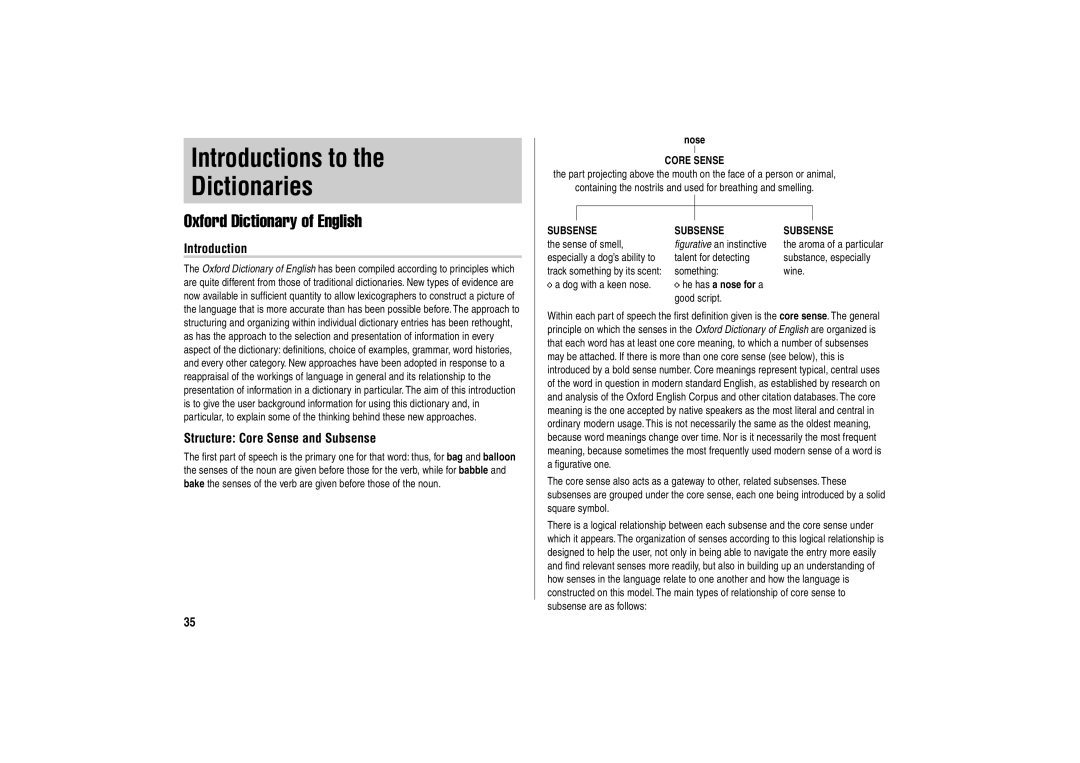
Introductions to the
Dictionaries
Oxford Dictionary of English
Introduction
The Oxford Dictionary of English has been compiled according to principles which are quite different from those of traditional dictionaries. New types of evidence are now available in sufficient quantity to allow lexicographers to construct a picture of the language that is more accurate than has been possible before. The approach to structuring and organizing within individual dictionary entries has been rethought, as has the approach to the selection and presentation of information in every aspect of the dictionary: definitions, choice of examples, grammar, word histories, and every other category. New approaches have been adopted in response to a reappraisal of the workings of language in general and its relationship to the presentation of information in a dictionary in particular. The aim of this introduction is to give the user background information for using this dictionary and, in particular, to explain some of the thinking behind these new approaches.
Structure: Core Sense and Subsense
The first part of speech is the primary one for that word: thus, for bag and balloon the senses of the noun are given before those for the verb, while for babble and bake the senses of the verb are given before those of the noun.
nose
CORE SENSE
the part projecting above the mouth on the face of a person or animal,
containing the nostrils and used for breathing and smelling.
SUBSENSE | SUBSENSE | SUBSENSE |
the sense of smell, | figurative an instinctive | the aroma of a particular |
especially a dog’s ability to | talent for detecting | substance, especially |
track something by its scent: | something: | wine. |
a dog with a keen nose. | he has a nose for a |
|
| good script. |
|
Within each part of speech the first definition given is the core sense. The general principle on which the senses in the Oxford Dictionary of English are organized is that each word has at least one core meaning, to which a number of subsenses may be attached. If there is more than one core sense (see below), this is introduced by a bold sense number. Core meanings represent typical, central uses of the word in question in modern standard English, as established by research on and analysis of the Oxford English Corpus and other citation databases. The core meaning is the one accepted by native speakers as the most literal and central in ordinary modern usage. This is not necessarily the same as the oldest meaning, because word meanings change over time. Nor is it necessarily the most frequent meaning, because sometimes the most frequently used modern sense of a word is a figurative one.
The core sense also acts as a gateway to other, related subsenses. These subsenses are grouped under the core sense, each one being introduced by a solid square symbol.
There is a logical relationship between each subsense and the core sense under which it appears. The organization of senses according to this logical relationship is designed to help the user, not only in being able to navigate the entry more easily and find relevant senses more readily, but also in building up an understanding of how senses in the language relate to one another and how the language is constructed on this model. The main types of relationship of core sense to subsense are as follows:
35
